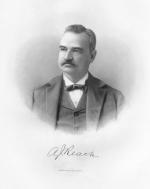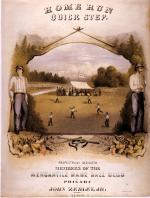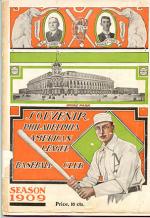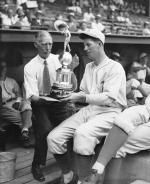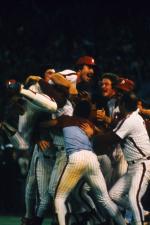Chapter Two: Baseball in Philadelphia
At the end of the Civil War, Brooklyn iron worker  Al Reach was burning up base paths and opposition pitchers as the star of the Brooklyn Eckfords, one of the finest amateur nines of early baseball history. When he was twenty-five years old, the Philadelphia Athletics made Reach an offer he couldn't refuse - the A's were willing to pay handsomely and aboveboard for the privilege of having Reach on their team. For $25 a week, Reach moved from New York to Philadelphia and became baseball's first true and open professional. When he departed the game almost half a century later, he was the owner of the Philadelphia Phillies of the National League. And the game he once played as an amateur had made him a millionaire.
Al Reach was burning up base paths and opposition pitchers as the star of the Brooklyn Eckfords, one of the finest amateur nines of early baseball history. When he was twenty-five years old, the Philadelphia Athletics made Reach an offer he couldn't refuse - the A's were willing to pay handsomely and aboveboard for the privilege of having Reach on their team. For $25 a week, Reach moved from New York to Philadelphia and became baseball's first true and open professional. When he departed the game almost half a century later, he was the owner of the Philadelphia Phillies of the National League. And the game he once played as an amateur had made him a millionaire.
In a sense, the evolutionary arcs of Al Reach and the game he loved can be traced as one. Over the course of Reach's career, baseball had grown from a simple recreational game into a very big business. Philadelphia played an integral part in that development, and continues to do so more than 130 years later.
In the early 1800s, Philadelphia still reached back to its English roots for recreation. Cricket was the most popular team activity in the city; town ball, a more chaotic, cruder English precursor to baseball, was widely played, too. By the 1830s, however, Philadelphians had imported from New York the game we now recognize as baseball, and the first amateur clubs were organized. In 1837, the most prominent of those clubs, the Olympic Ball Club, became the first club in America to write a constitution and a set of rules. The Olympics attracted the best players in town, and reigned in the city for nearly thirty years until the club was succeeded by the Athletics. Known as the A's - the oldest nickname in American professional sports - the Athletics became a magnet for the best players from lesser clubs throughout the city. By 1871, the A's were a fully professional team, playing in baseball's first all-professional major league.
Baseball thrived at other levels of play within the city. Wherever there was a vacant lot or an open field, groups of nine usually came together, informally or through social clubs and associations or sponsored by businesses. Philadelphia's growing black population also embraced the game. In the late 1860s Octavius Catto and
Octavius Catto and  Jacob C. White formed the Pythians, the first African-American team to compete against a white nine.
Jacob C. White formed the Pythians, the first African-American team to compete against a white nine.
In the first decade of the twentieth century, Hall of Famers Rube Foster and Pop Lloyd led the Philadelphia Giants to national renown. The Hilldale Daisies, who played in the Philadelphia area from 1910-1931, won the Negro National League championship in 1921, and the first official Colored World Series in 1924. Another black club, the Philadelphia Stars, enjoyed considerable longevity and popularity, playing baseball in the Negro National League from 1933-1952.
In 1876, the National League opened for business in eight cities from Boston to Chicago. The A's represented Philadelphia that first year before being cast adrift by the league at the end of the season. Realizing that a team in Philadelphia was important to the entire league's financial health, the league's president approached Reach about forming a franchise. In 1883, the Phillies debuted and became a cornerstone of the National League. Reach laid the foundation for a solid though unspectacular franchise, and built the team two ballparks: Reaction Park, which served as the Phillies' home between 1883 -1886, and Philadelphia Base Ball Park Baker Bowl, which the club called home from 1887-1938. It would take new ownership, however, and the strong right arm of 31-game winner Grover Cleveland Alexander to bring the Phillies their first pennant in 1915.
Baker Bowl, which the club called home from 1887-1938. It would take new ownership, however, and the strong right arm of 31-game winner Grover Cleveland Alexander to bring the Phillies their first pennant in 1915.
By then, of course, the Phillies was not the only team in town. When the American League opened its gates in 1901, league president Ban Johnson had installed his friend, the savvy former catcher Connie Mack, as part owner and manager of the team that Mack dubbed the Athletics. When rival manager John McGraw suggested that a second team in Philadelphia would be nothing but a white elephant, Mack laughed back, adopting the image of an albino pachyderm as his logo. Then he filled the team's roster with great pitchers and hitters.
Connie Mack, as part owner and manager of the team that Mack dubbed the Athletics. When rival manager John McGraw suggested that a second team in Philadelphia would be nothing but a white elephant, Mack laughed back, adopting the image of an albino pachyderm as his logo. Then he filled the team's roster with great pitchers and hitters.
Led by a batch of future Hall of Famers - pitchers Eddie Plank,
Eddie Plank,  Rube Waddell, and
Rube Waddell, and  Chief Bender, and batsmen Eddie Collins and Frank "Home Run" Baker - Mack erected a dynasty, winning pennants in 1902, 1905, 1910, 1911, 1913, and 1914. Mack won the last four in the team's stunning new home,
Chief Bender, and batsmen Eddie Collins and Frank "Home Run" Baker - Mack erected a dynasty, winning pennants in 1902, 1905, 1910, 1911, 1913, and 1914. Mack won the last four in the team's stunning new home,  Shibe Park, which opened in 1909, just west of their cross-town rivals. When the A's success stopped, however, it ended with a thud. Beset by economic problems and player raids by the short-lived Federal League, Mack released or sold his star players after the 1914 season and promptly dropped to the bottom of the American League. And that's where the Athletics lingered for seven straight seasons.
Shibe Park, which opened in 1909, just west of their cross-town rivals. When the A's success stopped, however, it ended with a thud. Beset by economic problems and player raids by the short-lived Federal League, Mack released or sold his star players after the 1914 season and promptly dropped to the bottom of the American League. And that's where the Athletics lingered for seven straight seasons.
While the Phillies wandered in pennant limbo for thirty-five years, Mack constructed another team that many consider the finest in baseball history. Built on the slugging strength of Jimmie Foxx, Mickey Cochrane, and Al Simmons, along with the left-handed genius of pitcher Lefty Grove, the team dominated baseball for three years. This A's team won back-to-back World Series in 1929 and 1930 before an upset by the Cardinals in the Fall Classic of 1931. The latter turned out to be the A's last pennant-winner in Philadelphia.
Faced with substantial financial difficulties in the early 1930s brought on by the Great Depression and banks' calling in loans the A's franchise had taken in the mid-1920s to modernize and expand Shibe Park, Mack was forced for a second time to sell off his best players. This time, the franchise never recovered. A lack of resources and a failure to keep up with changing times in baseball condemned the Athletics to mostly second division finishes in the 1940s and 1950s. In 1954, the American League shut its doors on Philadelphia, and the great White Elephant lumbered west to Kansas City.
Shibe Park, Mack was forced for a second time to sell off his best players. This time, the franchise never recovered. A lack of resources and a failure to keep up with changing times in baseball condemned the Athletics to mostly second division finishes in the 1940s and 1950s. In 1954, the American League shut its doors on Philadelphia, and the great White Elephant lumbered west to Kansas City.
The Phillies, on the other hand, gained a new wealthy owner named Robert R. M. Carpenter in 1943. For the first time in years, the club had real money behind it and Carpenter assembled one of the most exciting teams ever in Philadelphia. Behind the youthful Whiz Kids of Richie Ashburn, Robin Roberts, Del Ennis, and Jim Konstanty, the Phillies won the 1950 pennant, then promptly lost the World Series in four straight to the Yankees.
In 1964, the Phillies threatened to win the pennant again on the heroics of hard-hitting Richie Allen and Johnny Callison, and pitcher Jim Bunning, who hurled the National League's first perfect game of the twentieth century that season. But the team collapsed in the last two weeks of play when their six-and-a-half game lead evaporated like water on a hot day.
six-and-a-half game lead evaporated like water on a hot day.
Within a decade, the Phillies abandoned crumbling Connie Mack Stadium for a new state-of-the-art home - the all-purpose Veterans Stadium in South Philadelphia. Here, they finally assembled the players that would transport them to baseball's promised land. In 1980, with Larry Bowa, Pete Rose, Greg Luzinski, Gary Maddox, Tug McGraw and Hall of Famers Mike Schmidt and Steve Carlton, the Phillies won their first World Championship. Before the end of the century, they added another two pennants. Relocated to a new, retro-style home called Citizens Bank Park in 2004, the Phillies won a second World Series in 2009.
Veterans Stadium in South Philadelphia. Here, they finally assembled the players that would transport them to baseball's promised land. In 1980, with Larry Bowa, Pete Rose, Greg Luzinski, Gary Maddox, Tug McGraw and Hall of Famers Mike Schmidt and Steve Carlton, the Phillies won their first World Championship. Before the end of the century, they added another two pennants. Relocated to a new, retro-style home called Citizens Bank Park in 2004, the Phillies won a second World Series in 2009.
In a sense, the evolutionary arcs of Al Reach and the game he loved can be traced as one. Over the course of Reach's career, baseball had grown from a simple recreational game into a very big business. Philadelphia played an integral part in that development, and continues to do so more than 130 years later.
In the early 1800s, Philadelphia still reached back to its English roots for recreation. Cricket was the most popular team activity in the city; town ball, a more chaotic, cruder English precursor to baseball, was widely played, too. By the 1830s, however, Philadelphians had imported from New York the game we now recognize as baseball, and the first amateur clubs were organized. In 1837, the most prominent of those clubs, the Olympic Ball Club, became the first club in America to write a constitution and a set of rules. The Olympics attracted the best players in town, and reigned in the city for nearly thirty years until the club was succeeded by the Athletics. Known as the A's - the oldest nickname in American professional sports - the Athletics became a magnet for the best players from lesser clubs throughout the city. By 1871, the A's were a fully professional team, playing in baseball's first all-professional major league.
Baseball thrived at other levels of play within the city. Wherever there was a vacant lot or an open field, groups of nine usually came together, informally or through social clubs and associations or sponsored by businesses. Philadelphia's growing black population also embraced the game. In the late 1860s
In the first decade of the twentieth century, Hall of Famers Rube Foster and Pop Lloyd led the Philadelphia Giants to national renown. The Hilldale Daisies, who played in the Philadelphia area from 1910-1931, won the Negro National League championship in 1921, and the first official Colored World Series in 1924. Another black club, the Philadelphia Stars, enjoyed considerable longevity and popularity, playing baseball in the Negro National League from 1933-1952.
In 1876, the National League opened for business in eight cities from Boston to Chicago. The A's represented Philadelphia that first year before being cast adrift by the league at the end of the season. Realizing that a team in Philadelphia was important to the entire league's financial health, the league's president approached Reach about forming a franchise. In 1883, the Phillies debuted and became a cornerstone of the National League. Reach laid the foundation for a solid though unspectacular franchise, and built the team two ballparks: Reaction Park, which served as the Phillies' home between 1883 -1886, and Philadelphia Base Ball Park
By then, of course, the Phillies was not the only team in town. When the American League opened its gates in 1901, league president Ban Johnson had installed his friend, the savvy former catcher
Led by a batch of future Hall of Famers - pitchers
While the Phillies wandered in pennant limbo for thirty-five years, Mack constructed another team that many consider the finest in baseball history. Built on the slugging strength of Jimmie Foxx, Mickey Cochrane, and Al Simmons, along with the left-handed genius of pitcher Lefty Grove, the team dominated baseball for three years. This A's team won back-to-back World Series in 1929 and 1930 before an upset by the Cardinals in the Fall Classic of 1931. The latter turned out to be the A's last pennant-winner in Philadelphia.
Faced with substantial financial difficulties in the early 1930s brought on by the Great Depression and banks' calling in loans the A's franchise had taken in the mid-1920s to modernize and expand
The Phillies, on the other hand, gained a new wealthy owner named Robert R. M. Carpenter in 1943. For the first time in years, the club had real money behind it and Carpenter assembled one of the most exciting teams ever in Philadelphia. Behind the youthful Whiz Kids of Richie Ashburn, Robin Roberts, Del Ennis, and Jim Konstanty, the Phillies won the 1950 pennant, then promptly lost the World Series in four straight to the Yankees.
In 1964, the Phillies threatened to win the pennant again on the heroics of hard-hitting Richie Allen and Johnny Callison, and pitcher Jim Bunning, who hurled the National League's first perfect game of the twentieth century that season. But the team collapsed in the last two weeks of play when their
Within a decade, the Phillies abandoned crumbling Connie Mack Stadium for a new state-of-the-art home - the all-purpose







